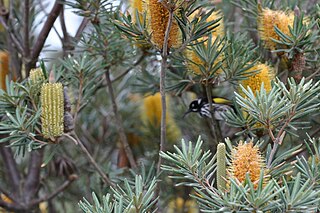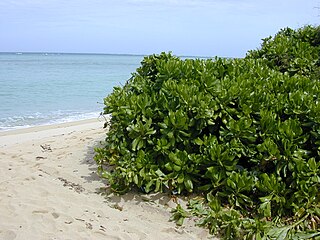
Scaevola is a genus of flowering plants in the Goodenia family, Goodeniaceae. It consists of more than 130 tropical species, with the center of diversity being Australia and Polynesia. There are around 80 species in Australia, occurring throughout the continent. Diversity is highest in the South West, where ca. 40 species are endemic.

Hydrilla is a genus of aquatic plant, usually treated as containing just one species, Hydrilla verticillata, though some botanists divide it into several species. It is native to the cool and warm waters of the Old World in Asia, Africa and Australia, with a sparse, scattered distribution; in Australia from Northern Territory, Queensland, and New South Wales.

Ilex verticillata, the winterberry, is a species of holly native to eastern North America in the United States and southeast Canada, from Newfoundland west to Ontario and Minnesota, and south to Alabama.
Quintus Mucius Scaevola Pontifex was a politician of the Roman Republic and an important early authority on Roman law. He is credited with founding the study of law as a systematic discipline. He was elected Pontifex Maximus, as had been his father and uncle before him. He was the first Roman Pontifex Maximus to be murdered publicly, in Rome in the very Temple of the Vestal Virgins, signifying a breakdown of historical norms and religious taboos in the Republic.

Banksia verticillata, commonly known as granite banksia or Albany banksia, is a species of shrub or (rarely) tree of the genus Banksia in the family Proteaceae. It is native to the southwest of Western Australia and can reach up to 3 m (10 ft) in height. It can grow taller to 5 m (16 ft) in sheltered areas, and much smaller in more exposed areas. This species has elliptic green leaves and large, bright golden yellow inflorescences or flower spikes, appearing in summer and autumn. The New Holland honeyeater is the most prominent pollinator, although several other species of honeyeater, as well as bees, visit the flower spikes.
Inkberry is a common name for several unrelated plants:

Asclepias verticillata, the whorled milkweed, eastern whorled milkweed, or horsetail milkweed, is a species of milkweed native to most all of eastern North America and parts of western Canada and the United States.

Coreopsis verticillata is a North American species of tickseed in the sunflower family. It is found primarily in the east-central United States, from Maryland south to Georgia, with isolated populations as far west as Oklahoma and as far north as Québec and Ontario. The common names are whorled tickseed, whorled coreopsis, thread-leaved tickseed, thread leaf coreopsis, and pot-of-gold.

Fritillaria verticillata is an Asian plant in the lily family, native to Japan, Korea, Mongolia, Xinjiang, Kazakhstan, and the Altay region of Siberia.

Scaevola aemula, the fairy fan-flower or common fan-flower, is a small shrub in the family Goodeniaceae, native to southern Australia. It grows to 50 cm in height and produces white or blue flowers in spikes up to 24 cm long from August to March in its native range. These are followed by rounded, wrinkled berries to 4.5 mm in length.

Allocasuarina verticillata, commonly known as drooping she-oak or drooping sheoak, is a nitrogen fixing native tree of southeastern Australia. Originally collected in Tasmania and described as Casuarina verticillata by French naturalist Jean-Baptiste Lamarck in 1786, it was moved to its current genus in 1982 by Australian botanist Lawrie Johnson.

Scaevola coriacea, the dwarf naupaka, is a species of flowering plant in the Goodenia family, Goodeniaceae, that is endemic to Hawaii.

Scaevola hookeri, the creeping fan-flower or alpine fan-flower, is a prostrate perennial herb in the family Goodeniaceae. It is native to eastern Australia. Leaves are 6 to 50 mm long and 2 to 15 mm wide. Flowers are white or blue with a yellowish throat and appear between December and March in the species native range. The species was first formally described by W.H. de Vriese in 1850 in Nederlandsch Kruidkundig Archief and given the name Merkusia hookeri. The species was transferred to the genus Scaevola in 1856. It occurs in grassland and woodland in high altitude areas in Victoria, New South Wales, Tasmania, and also South Australia where it is listed as "endangered".
Udea constricta is a moth of the family Crambidae. It is endemic to the Hawaiian islands of Kauai, Oahu and Molokai.

Erica verticillata is a species of Erica that was naturally restricted to the city of Cape Town but is now classified as Extinct in the Wild.

Scaevola taccada, also known as beach cabbage, sea lettuce, beach naupaka, naupaka kahakai (Hawaiian), magoo (Divehi), merambong (Malay), bapaceda or papatjeda, ngahu (Tongan) is a flowering plant in the family Goodeniaceae found in coastal locations in the tropical areas of the Indo-Pacific. It is a common beach shrub throughout the Arabian Sea, the tropical Indian Ocean and the tropical Islands of the Pacific.
The plant genus Stilbe was described in 1767, originally as being in the Verbenaceae, but the genus now is placed in the family Stilbaceae. The entire genus is endemic to the Cape Province region of South Africa.
Coenobita scaevola is a species of terrestrial hermit crab from the western Indian Ocean and Red Sea.
















